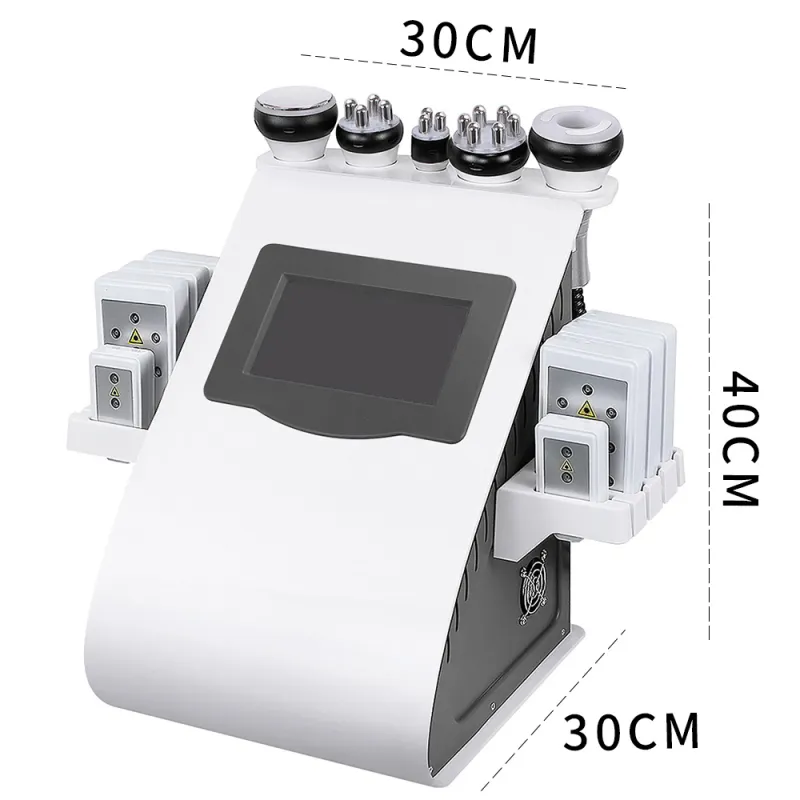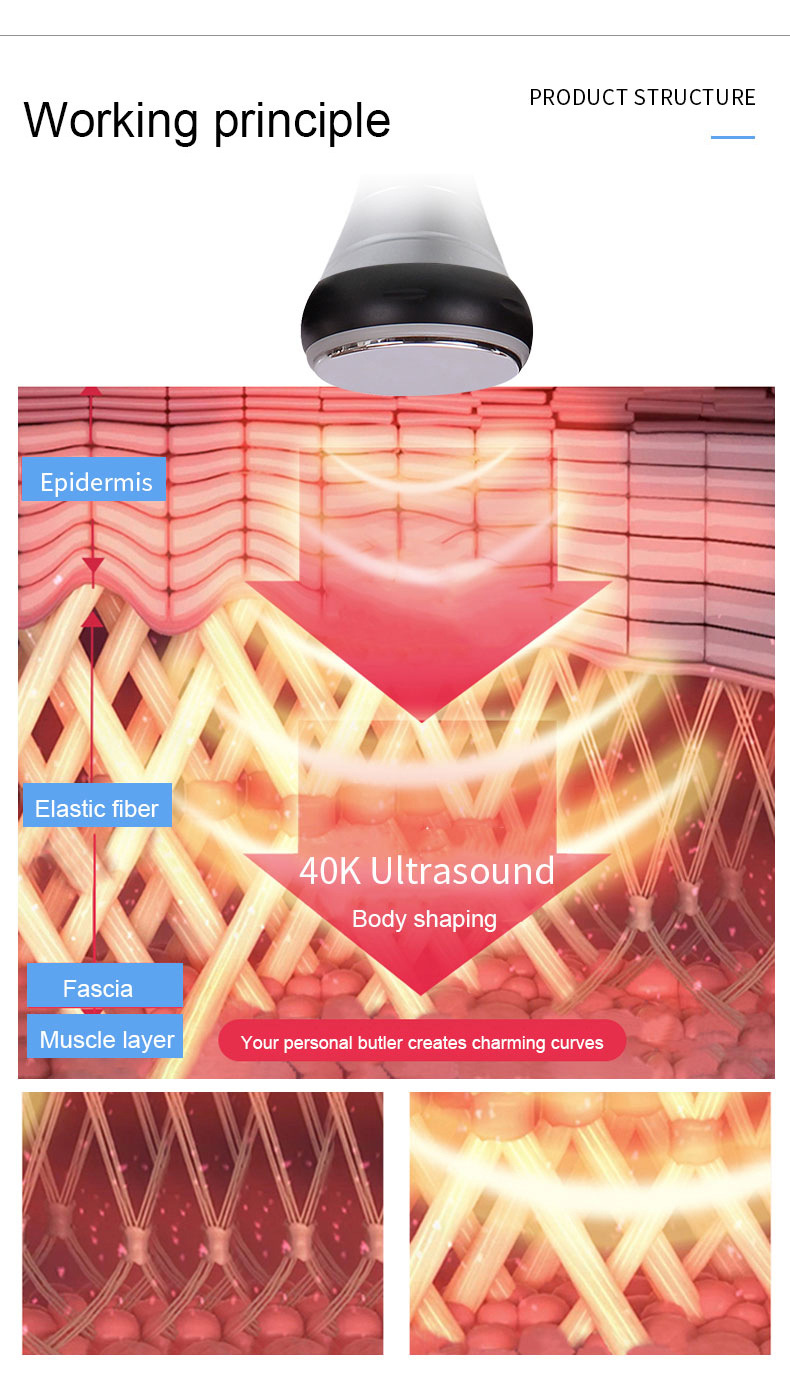
Will an ultrasonic fat cavitation machine damage non-fat cells?
2025-11-07 15:30
Among numerous technologies, the "ultrasonic fat cavitation machine" is widely used in beauty and medical institutions due to its non-invasive, efficient, and convenient characteristics. This device uses low-frequency ultrasound to create a cavitation effect, destroying the structure of fat cells, thereby achieving localized fat reduction and body shaping.
The public and some practitioners have questions about the "selective" mechanism of this device: Does the ultrasonic fat cavitation machine only act on fat cells? Is it possible to damage other non-fat cells?
To accurately answer this question, this article will conduct an in-depth analysis from five dimensions: technical principles, the biological effects of ultrasound, structural differences between fat cells and non-fat cells, physiological reactions, experimental observations, and safety boundaries, comprehensively evaluating the selectivity and safety of the "ultrasonic fat cavitation machine" in practical applications.

What is the working principle of an ultrasonic fat cavitation machine?
1. Introduction to the Cavitation Effect
"Cavitation" refers to the rapid formation of tiny bubbles in a liquid due to pressure changes, and the release of localized high-energy shock waves and shear forces when these bubbles burst. This effect is commonly seen in tissues exposed to high-intensity ultrasound.
2. Mechanism of Ultrasonic Fat Cavitation Machines
Ultrasonic fat cavitation machines typically operate at low frequencies (approximately 40kHz to 60kHz), where mechanical waves can more easily penetrate the skin and reach the subcutaneous fat layer. When these ultrasound waves reach adipose tissue, they generate numerous microbubbles in the tissue fluid. During the formation, expansion, and rupture of these bubbles, the released energy puts pressure on the fat cell membranes, ultimately causing the membrane structure to rupture. Intracellular lipids (such as glycerol and free fatty acids) are released into the intercellular space and metabolized via the lymphatic system.
This process is called nonthermal, nondestructive lipolysis, a relatively gentle yet effective fat intervention technique.

Structural Differences Between Adipose and Non-Adipose Tissues
1. Biological Characteristics of Adipocytes
Adipocytes are highly specialized cells, most notably characterized by large lipid droplets filling their cytoplasm, occupying over 90% of their cell volume. The characteristics of this structure determine that:
• Abundant lipid droplets fill the cell interior, making the cell membrane relatively fragile;
• The cell nucleus is compressed at the cell edge;
• Compared to other cell types, adipocytes are more sensitive to physical forces (such as vibration and traction).
These characteristics make adipocytes more susceptible to damage when subjected to cavitation induced by sound waves, thus more easily releasing lipid substances.
2. Shock Resistance of Non-Adipose
Tissue Compared to adipose tissue, non-adipocytes (such as muscle cells, nerve cells, and connective tissue cells) have the following characteristics:
• More compact cell structure with a higher proportion of cytoplasm;
• Relatively robust cell membranes with strong mechanical resistance;
• Regularly arranged within the tissue, with strong intercellular connections, making them less susceptible to disruption by local disturbances.
This means that, under the same energy input, non-adipocyte tissue has a lower "response" to cavitation effects and is less prone to tissue rupture or damage.
Effects of Ultrasonic Cavitation on Different Cell Types
1. Selectivity of Cavitation Effect
The destructive power of cavitation does not directly "recognize" adipocytes, but rather achieves indirect selectivity in biological tissues through physical mechanisms. The main factors influencing this selectivity include:
• Tissue density: Adipose tissue has a lower density, making it easier for cavitation bubbles to accumulate;
• Acoustic impedance matching: The acoustic impedance of adipose tissue matches cavitation waves better, resulting in higher energy absorption;
• Blood perfusion rate: Adipose tissue has less blood supply and poor heat dissipation, making it easier for energy to accumulate locally.
In summary, cavitation waves have a stronger focusing effect on adipose tissue, while non-adipate tissues, due to their different biophysical characteristics, have lower cavitation wave transmission efficiency and stronger tissue tolerance, thus experiencing minimal impact.
2. Effects of Shear Force on Cell Membranes
Adipocyte membranes are under continuous tension due to the large size of their internal lipid droplets, and ultrasound-induced shear waves easily cause membrane rupture. In contrast, other cells, such as fibroblasts, have a more uniform membrane structure and are not under critical tension, making them less susceptible to damage.

Safe Dosage and Energy Control: Critical Operating Boundaries
The safety of using an "ultrasonic fat cavitation machine" depends not only on the selectivity of the device's operating principle but also on energy control, time control, frequency selection, and probe movement during specific operations. The following parameters are crucial:
1. Energy Intensity (Power)
The device's output power is typically controlled between 30 and 150 W. Exceeding this threshold may cause micro-tissue damage. Therefore, adhering to the specified power range is essential to avoid damage to non-target cells.
2. Frequency Selection
40 kHz is widely used in "ultrasonic fat cavitation machines" because it creates the most significant cavitation effect in the subcutaneous tissue layer at 4-5 cm, without affecting deeper muscle tissue or internal organs.
3. Probe Movement and Operation Technique
Continuous static manipulation of a single area may cause excessive cavitation, leading to local tissue stress. Therefore, clinical recommendations dictate that the probe be moved slowly and evenly over the target area to avoid concentrated action.
4. Operation Time
Each operation is recommended to be limited to 15-30 minutes to avoid inducing unnecessary tissue reactions due to excessive stimulation.
Evaluation of the Impact of Existing Research on Non-Adipocytes
1. Tissue Microscopy
Multiple in vitro and animal experiments have shown that at the correct dosage, the "ultrasonic fat cavitation machine" significantly damages adipocytes, but no morphological abnormalities were observed in adjacent fibroblasts, capillaries, or dermal cells.
2. Cell Viability Assay
Chromosomal integrity assays (e.g., TUNEL assay, Annexin V assay) revealed membrane rupture in adipocytes, while no significant apoptosis or necrosis was observed in non-adipocytes.
3. Changes in Clinical Biochemical Parameters
No abnormal increases in indicators such as liver enzymes and creatine kinase were observed after treatment, indicating no systemic tissue damage.

Special Circumstances: When May Non-Adipocytes Be Damaged?
The ultrasonic fat cavitation machine may potentially affect non-adipocytes under the following specific conditions:
• Excessive operating energy: such as excessive power or inappropriate frequency.
• Prolonged fixed-point probe operation: may lead to localized stress responses in non-adipocytes.
• Thin skin or localized diseased tissue: Increased risk of compression of epidermal cells or basement membrane.
• Overly frequent treatment: Repeating the procedure before tissue repair is complete may lead to cumulative damage.
This suggests that practitioners must strictly adhere to operating procedures to avoid affecting non-target tissues due to misoperation.
Does fat cavitation damage non-fat cells?
Based on the above analysis, the following conclusions can be drawn:
• Under correct operating conditions, the ultrasonic fat cavitation machine primarily damages fat cells, exhibiting high relative safety for non-fat cells.
• Fat cells, due to their fragile structure and acoustic impedance mismatch, are the primary targets of the cavitation effect.
• Non-fat cells, such as muscle fibers, dermal cells, and capillaries, are not easily affected within the clinical energy range.
• Standardized operation is the key to avoiding damage to non-fat tissues.
Therefore, under professional guidance and proper application, the ultrasonic fat cavitation machine is a non-invasive fat-dissolving technology with high tissue selectivity and good safety. Its impact on non-fat cells is extremely limited, and it can be considered a cosmetic fat reduction device with clear targeting and tissue protection.
Can KuoHai offer discounts for large orders?
Yes. KuoHai provides special discounts and promotional prices for bulk orders and long-term cooperation. We believe in rewarding loyal customers through competitive wholesale pricing and seasonal promotions. If you plan to purchase in bulk, our sales team can tailor a discount plan that fits your business goals. With factory-direct offers and stable production, KuoHai ensures the best value for your investment in high-quality Chinese beauty machines.
Get the latest price? We'll respond as soon as possible(within 12 hours)







